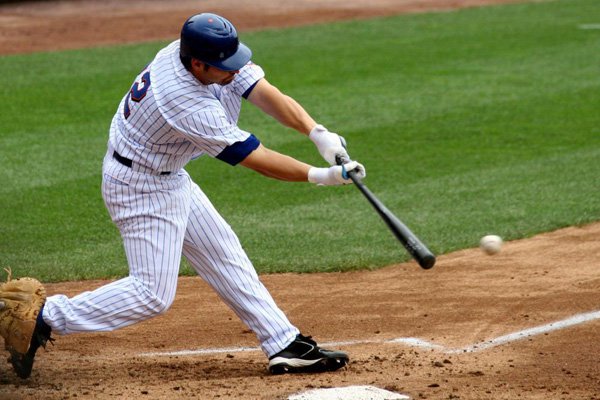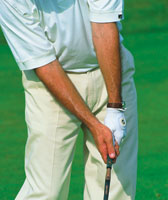
Earle Bryan "The Kentucky Colonel" Combs was born on May 14, 1899 in Pebworth,KYof Scotch-German descent. TheCumberland Mountainsof the Blue Grass State served as rural backdrop for his father's hillside farm. He and his six siblings had little time to concentrate on sports because of their agricultural chores. He received his teaching certificate at Eastern Teachers College (KY) in 1920 and taught in a one room mountain hall where he had forty students ranging from6to 16 years of age. An adjacent playground served as a training ground for the students where he honed his skills as player-manager for a local semi-pro team. Earle then required the blessing of his father to sign a minor league contract offered by the Louisville Colonels of the American Association that began in 1922. After two productive years hitting.344 and.380 respectively, "The Mail Carrier" was sold to the New York Yankees for $50,000. He stood 6 foot tall and weighed 185 pounds. Combs batted left handed; however threw and wrote with his right hand.
By 1924 he finished the season with the Yankees where he would remain their starting "ball hawk", fleet-footed centerfielder and patient leadoff hitter until 1935. As "table setter", he was followed in the lineup by Lazzeri, Ruth, Gehrig and Dickey for most of his career. The iron-grey haired Combs was adept at bunting and the greatest leadoff hitter beforeRicky Henderson blasted onto the scene. His.325 batting average was complimented by the fact that he scored (1,186) almost half the time he reached base safely. Possessing an accurate arm, Earle also made a number of great catches in the field. Three serious injuries occurred during his career. The first was a broken ankle his rookie season and the last was a 1934 broken collar bone that virtually ended his career. But the most severe came in July of 1934 while chasing a fly ball hit by Harland Clift in Sportsman's Park inSt. Louis, Combs crashed into the wall and smashed his head and broke his shoulder. Earle was carried unconscious from the field and spent two months in the hospital. His abilities were never the same and he retired shortly thereafter onJuly 28, 1935. Earle remained on the Yankees coaching staff until 1944, then had brief stints instructing for the Browns in 1947, the Red Sox from 1948-52 and finally with thePhillies in 1954. Combs retired from baseball and spent the remaining years farming on a beautiful 430-acre lot inRichmond,KY. He served as Kentucky Banking Commissioner and on the board of regents atEasternKentuckyUniversity. He died after a long illness onJuly 21, 1976in his adopted town at the age of 77. Combs was interred with a large headstone inRichmondCemetery. He was survived by his wife Ruth McCullom (married 1922) of his birth town. They had three sons, Earle, Jr. (1925), Charles (1928) and Donald (1931). Also surviving his death was a brother Conley Combs and a sister Elsie Seale and twelve grandchildren.
All accounts of the "Kentucky Colonel", as named by the press, was that he was a perfect gentleman. In 1928 the Yankee bleacher fans bestowed an engraved watch to the popular, classy outfielder. He was equally respected by his teammates who enjoyed his warm personality. He was easy to handle as a model player for both Huggins and McCarthy. Very religious, he read the Bible daily, did not smoke, drink or use profanity. He was chosen as a pallbearer at Miller Huggins' funeral inCincinnati. Combs signed generously in person as well as through the mail like most players from his era. The requests at that time were not overwhelming unlike the demands of the hobby today. His induction (#116) into The National BaseballHall of Fame onJuly 27, 1970boosted his popularity beyond his affiliation as a member of the elite 1927 Murderer's Row Team. The Old Timers Committee selected him and his modest and self-effacing response on the podium went as follows "When I heard I'd been named it was like a bullet shot between my eyes. It was the last thing I expected. I thought theHall of Fame was for superstars, not just average players like I was." Subsequently, he also attended the next two year's enshrinement ceremonies and stayed at the Otesaga Hotel inCooperstown. For three years after his enshrinement, he dutifully responded to SASE (self-addressed stamped envelope) requests, however failing health in the final three years of his life initiated his wife, Ruth, to accommodate autographs seekers. Her "ghost" signature simulated his version although her inability to recreate the ornate "E" was what exposed this non-malicious accommodating practice. She legitimized this practice because she didn't want a young collector to be disappointed in not receiving a positive response. Most collections of goldHall of Fame plaque postcards that I have examined have had the worthless Mrs. Combs example.
On some occasions, Combs' signature during his playing career was "clubhouse-signed" on team signed baseballs, often with the omission of the final "e" in his first name. This would occur generally when Combs was not readily available in the clubhouse and the duties were relegated to longtime attendant Pete Sheehy or atrustybatboy. Combs would always sign on the side panel of a team baseball leaving the hallowed sweet spot for the Bambino or later on Gehrig autographs. Certainly, the two capital letters in his signature were the most distinguished letters in his signature. The "E" would overpower the balance of the letters often being four times their size. Even the large stemmed lower case letters, "l" and "b" were dwarflike in comparison. During his playing career his "C" was coiled and rounded eventually evolving into a more numerical 6.
Combs is one of those signatures that is somewhat undervalued because many collectors are unaware that the signature they covet is that of his wife, Ruth. This was confirmed to me by his granddaughter Laura Combs-Bolin. If all of the people were to realize this problem then upgrading their collections would cause a demand for Combs' actual signature and prices would rise 50%. As it stands now, 3" x 5" index cards are priced at $85, government postcards about $135, gold CurtiechcolorHall of Fame plaque postcards and cancelled checks around $200, 8" X 10" black and white photographs (usually a bust shot in a New York Yankee uniform signed in felt tip marker) fetch $350 and single signed baseballs start at $2000. Signed baseball cards from his playing career surface, however, more often one will find 1961 Fleer All-Time Greats or TCMA autographed versions far more available. Handwritten letters are uncommon but expect to pay a minimum of $400. Forget about running down a single-signed bat, jersey or a post-mortem Perez-Steele postcard of any kind.


Breathing Techniques for Swimming

Copyright © www.mycheapnfljerseys.com Outdoor sports All Rights Reserved